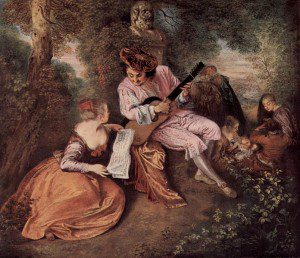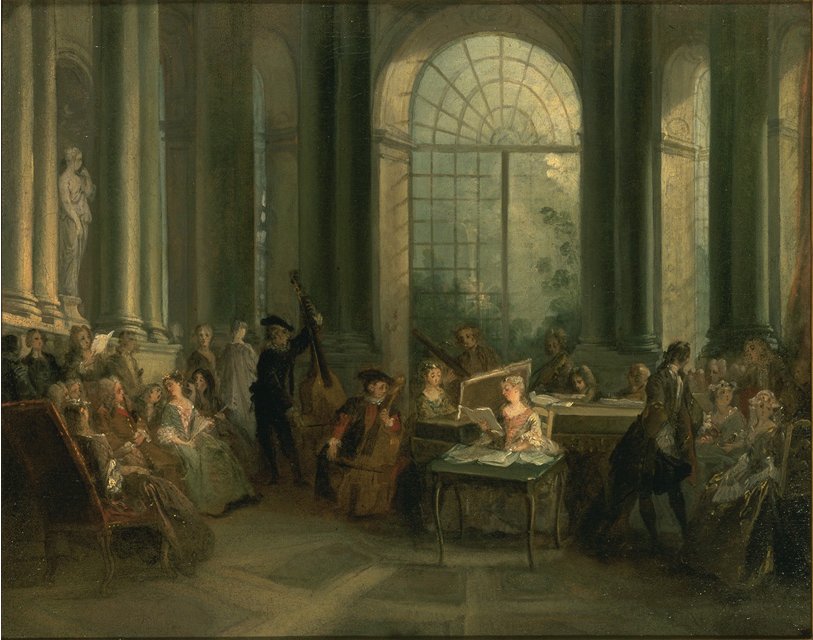Originally appeared in Tempesta di Mare’s October-November 2013 newsletter regarding the chamber program Holiday in Paris: Telemann’s Musical Vacation, November 23 and 24, 2013.
How do you capture a memory?

In 1737, during a visit to Paris, German composer Georg Philipp Telemann got to hear his new Paris Quartets premiered by some of France’s best musicians, a remarkable experience that Tempesta di Mare brought back to life in their November 2013 program, Holiday in Paris: Telemann’s Musical Vacation. Later, he wrote about it:
“The marvelous way in which these quartets were played deserves mention here, if indeed words can convey any impression…”
Words? Let’s have a fantasy interlude!
***
You come in out of the cold and reeking Paris streets. It’s warm inside. Baskets of roses, orange blossoms and jasmine flowers make the air sweet. You enter your hostess’s salon, a gorgeous, high-ceilinged paneled room with fine paintings and opulent fabrics on the walls. The murmur of many voices greets you. Parisian high society has gathered in full fashionable array and they’re doing one of the many things at which they excel: talk.
You’re greeted and shown around. Before long, you’re chatting with strangers as though you’ve been friends for life. You astounded by the exhilaration of Parisian conversation. Everybody is interested in you and you’re interested in everybody. Your new friends draw you out and put you at ease with such skill that you are finding yourself being much more clever than usual (“I really need to write this down when I get back tonight,” you think, slightly dazed).
You’re offered exquisite, fresh tasting foods and fine wines. Your companions are happy and beautiful. Luscious silks and laces rustle, jewels glisten, décolleté glows.
After the meal, when the musicians set up to play, it’s as if they were picking up the same conversations. They’re supremely skillful and effortlessly cool. Flute, violin, viol and harpsichord toss sweet bon mots back and forth. Like the gorgeous company around it, the music gossips and flirts, dances and sings.
Ahhh, if only life were always like this, life in the salons of baroque Paris.
***
End of fantasy interlude, back to real life! Confession: I’ve taken some license here by setting Telemann’s dream evening in a Parisian salon, because he didn’t tell us where it took place. But it’s likely that it took place in one of the salons, or someplace like them. Paris’s salons offered a moment of legendary beauty and refinement that by 1737 permeated all of French culture.
Salon society burst into being in the early 1600’s when a few indomitable women outside of court started opening their houses and apartments to high society gatherings. There, they encouraged rigorous self-improvement and behavior of the highest refinement. It’s speculated that these original salons were offered as a therapy to the harsh and brutish habits of the court nobility (intrigues, treachery, civil war—Three Musketeers territory).

Galanterie and le bon gout ruled there, concepts that clumsy English translations like “graciousness” and “good taste” don’t even get close to. Even the salonnières admitted that their world had a certain je ne sais quoi, a certain “I don’t know what,” something wonderfully natural and French that was impossible to describe—but you knew it when you saw it (or heard it).
By 1737, more than 50 salons had become fixtures of Parisian high society. There, the beautiful people met—opinion makers, aristocrats, technocrats and financiers, along with literati, philosophes, artists, and musicians—and defined the city’s noble way of life. Their mark on French culture, from Enlightenment thought to the then-new classic cuisine, is indelible.
The salons were full of music. Music-mad hosts and hostesses even had private concert halls with standing orchestras and the city’s most sought-after soloists. Music evolved with the lightness and lilt of French social dance and the sweet cadences of French speech.
Or so we’re told. When the era closed—with revolution and the Terror—French baroque music went away too. Music manuscripts remained, but it’s hard to get je ne sais quoi from paper. Too bad there were no field recordings! Far into the baroque revival and long after Italian and German music had returned to modern repertoire, French baroque performance practices remained by-and-large a tantalizing grey area.
It took decades of immersion for a new generation of musicians to master the elusive dialects of French baroque music and bring its indefinable air of galanterie back to life. In November, thanks to Tempesta di Mare and their fine musical conversation, audiences will be able to close their eyes and lose themselves once again in the heady scent of roses, the robust flavor of burgundy, the soft rustle of lace, and the riches of true civilization, as Tempesta takes us along to join Telemann on his wonderful Paris holiday.
